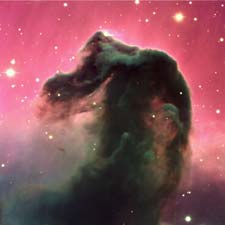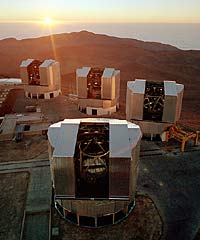
Silhouetted on a field of glowing hydrogen, the Horsehead Nebula in Orion is one of the most famous scenes in astronomy. This striking new image comes from the Very Large Telescope (VLT) facility in Chile. Click for larger view, or choose a full-resolution version from the European Southern Observatory's press release.
Courtesy ESO.
If astronomers had to name the most powerful optical observatory in the world today, their top pick would probably be the European Southern Observatory's Very Large Telescope facility on Cerro Paranal in Chile. Its four new 8.2-meter (330-inch) reflectors nose out the two 10-meter (400-inch) telescopes of the Keck Observatory in Hawaii for total light-gathering ability. Just as importantly, the four telescopes are equipped with a growing arsenal of some of the most powerful and versatile "back end" instruments — cameras, spectrographs, and the like — ever built.
Moreover, the observatory's engineers hope eventually to merge light waves from all four telescopes so precisely that they can work together to give the resolution (sharpness of view) of a single telescope 200 meters wide.

The VLT at sunset. Four 8.2-meter telescopes form the heart of the European Southern Observatory's Very Large Telescope facility on Cerro Paranal in Chile.
Courtesy ESO.
VLT astronomers recently released a striking image of the Horsehead Nebula to show off some of what their instruments can already do. This view was assembled from frames taken in red, green, and blue light by the wide-field FORS2 multimode camera on the VLT Kueyen telescope. (The telescopes are named Antu, Kueyen, Melipal, and Yepun for astronomical objects in the local language, Mapuche.) The field is nearly 7 arcminutes wide, unusually large for a telescope this size. The resolution was limited by the atmospheric seeing to about 0.75 arcsecond. The colors are approximately true.
The Horsehead is a cloud of gas and dust that's being eroded and shaped by ultraviolet light from the hot star Sigma Orionis outside the top of the view. Bluish areas are dust reflecting starlight. Stars buried inside the dust are dimmed and deeply reddened.
 0
0
Comments
You must be logged in to post a comment.